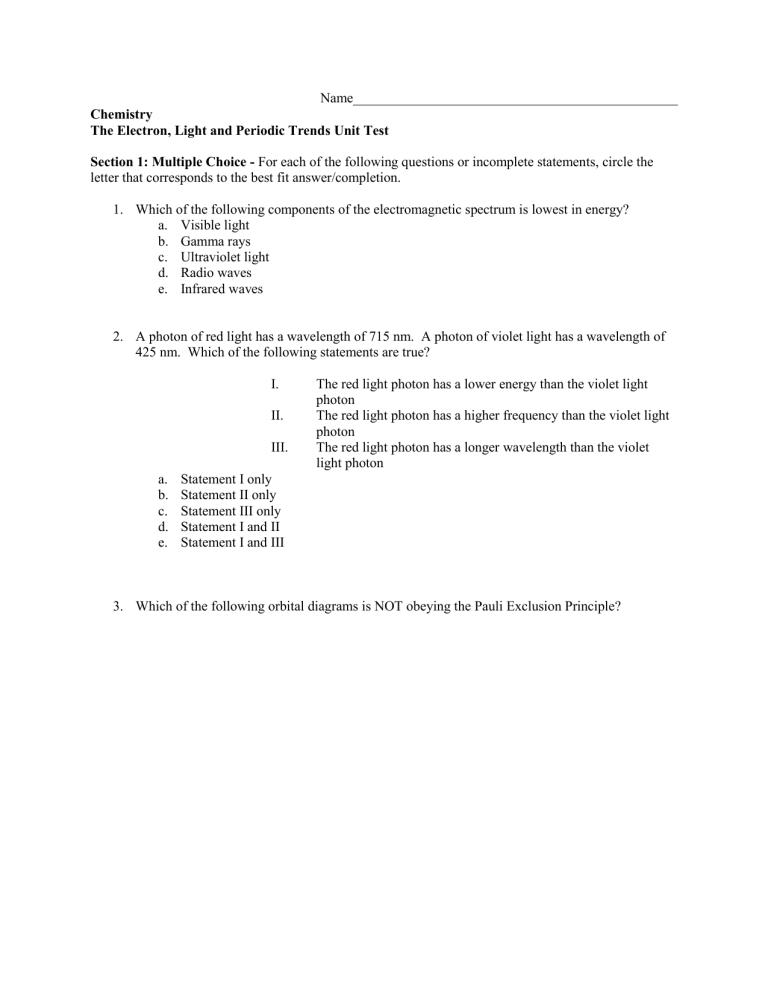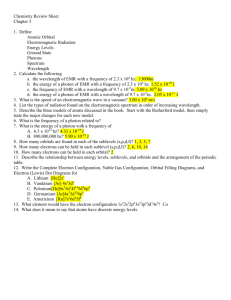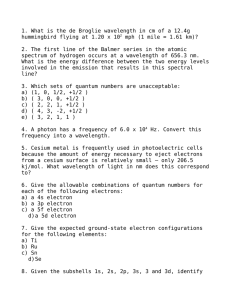LightandElectronUnitTest
advertisement

Name_______________________________________________ Chemistry The Electron, Light and Periodic Trends Unit Test Section 1: Multiple Choice - For each of the following questions or incomplete statements, circle the letter that corresponds to the best fit answer/completion. 1. Which of the following components of the electromagnetic spectrum is lowest in energy? a. Visible light b. Gamma rays c. Ultraviolet light d. Radio waves e. Infrared waves 2. A photon of red light has a wavelength of 715 nm. A photon of violet light has a wavelength of 425 nm. Which of the following statements are true? I. II. III. a. b. c. d. e. The red light photon has a lower energy than the violet light photon The red light photon has a higher frequency than the violet light photon The red light photon has a longer wavelength than the violet light photon Statement I only Statement II only Statement III only Statement I and II Statement I and III 3. Which of the following orbital diagrams is NOT obeying the Pauli Exclusion Principle? 4. Which of the following components of the electromagnetic spectrum will have the highest frequency? a. Radio waves b. Microwaves c. X-rays d. Visible light e. Infrared waves 5. The distance between two consecutive “like” points on a wave is called the_________________. a. Amplitude b. Frequency c. Speed d. Energy e. Wavelength 6. The Pauli Exclusion Principle states…. a. Electrons exist on orbits of quantized energy. b. One must fill in an electron orbital diagram from low energy to high energy. c. When adding electrons to orbitals in the same sublevel, one must first add one electron to each orbital, then go back and pair electrons. (aka the empty bus-seat rule.) d. Electrons sitting in the same orbital must have opposite spin. e. We cannot measure the position and momentum of an electron simultaneously. 7. What element has the following ground state electron configuration: 1s22s22p63s23p64s23d6 a. Cl b. Mn c. Fe d. Ru e. K 8. The number of times a wave repeats its motion in one second is called the ______________________ of the wave. a. Energy b. Speed c. Wavelength d. Time e. Frequency Section II: Free response – Answer each of the following questions carefully and completely. For calculations, you must show all work to receive credit for you answer, even if you are correct. 1. Calculate the frequency of light that has a wavelength of 250.2 nm. 2. What is the wavelength of a photon of yellow light that contains 3.61 x 10-19 J of energy? 3. Calculate the energy of a radio wave that has a frequency of 9.23 x 107 Hz. 4. List the 7 main components of the electromagnetic spectrum, in order, from high energy to low energy. HIGH ENERGY-----------------------------------------------------------------------------------------------LOW ENERGY 5. The diagram to the right shows four possible electron emissions. Use the diagram to answer the following questions. a. Is energy being absorbed or released in the diagram? How do you know? b. There are four wavelengths present in the diagram: violet, blue, green, and red. Which atom represents each color? c. Explain the difference between an atom in its ground state and an atom in its excited state. 6. Draw an orbital diagram that represents an Argon atom in an excited state. 7. Draw orbital diagrams for the following elements: a. Cu b. Pd c. Ar 8. Write the complete electron configurations for the following elements: a. Rb___________________________________________________ b. Au __________________________________________________ c. Se____________________________________________________ 9. Write the abbreviated electron configurations for the following elements: a. Ti ______________________________________ b. Mg_____________________________________ c. I _______________________________________ 10. Write an equation that illustrates the relationship between the energy of a light wave and its wavelength. 11. EXTRA CREDIT: Describe Werner Heisenberg’s involvement with the atomic bomb and its development.





